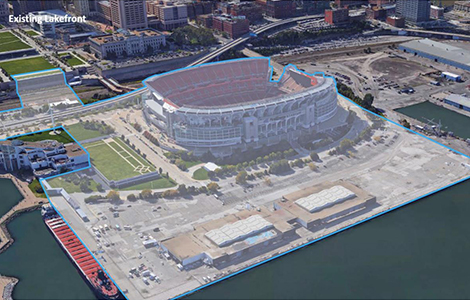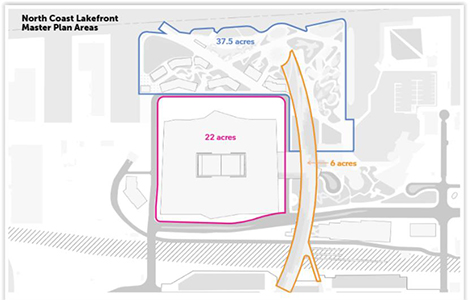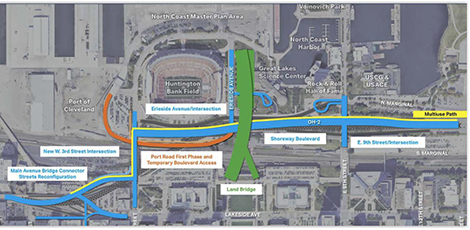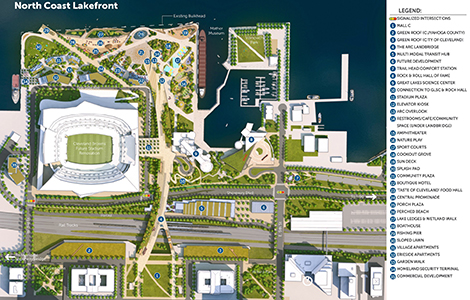The article is published as part of an exclusive content-sharing agreement with neo-trans.blog.
Huntington Bank Field may not be located on Downtown Cleveland’s lakefront for much longer after a new, enclosed stadium is built in suburban Brook Park. If so, what should replace it? And who should do it? The answer to those questions will be the result of a request for qualifications (RFQ) issued by the city and its partners today.
Interestingly, the land being offered up for development isn’t just the 22-acre site on which the football stadium sits. It’s also the 37.5 acres of land north and east of it, extending right up to the edge of Lake Erie. And there’s the 6-acre Land Bridge planned by the city.
Of that, about 15 acres will be reserved as public park and/or privately operated publicly accessible space, according to the RFQ, leaving about 50 acres of lakefront land available for development.
The city is offering the land because the Cleveland Browns — the current tenants of the city-owned Huntington Bank Field — have given notice that they do not intend to seek a renewal of their 30-year lease to that stadium. Their lease expires after the 2028 National Football League season.

So the RFQ was issued in partnership with the nonprofit North Coast Waterfront Development Corporation (NCWDC) and real estate brokerage CBRE. From it, the hope is to identify development partners for a portion of the downtown’s lakefront.
Prospective development partners could respond as master developers, developers of specific site portions, or developers focused on particular uses, city officials said in a written statement issued to the public today. Officials said they hope to select one or more developers by Oct. 24.
They explained that they want developers who are interested in helping to shape “a world-class waterfront grounded in the guiding principles of the North Coast Master Plan, which reflects values expressed by Clevelanders from all walks of life.”
But that plan had assumed the stadium would be there. So this RFQ is treating that piece as a potential blank slate. Because this is former submerged land recovered from Lake Erie, the city cannot sell the land, however. So the city is offering ground leases of up to 75 years with two 50-year extensions.

The city is proposing discounted land lease payments for developers and other end users who help the project achieve goals of access, equity, or present extraordinary economic opportunities. A 15-year, 85 percent residential real estate tax abatement and a 10-year, 75 percent commercial real estate tax abatement are also offered.
And city officials are leaving open the possibility of keeping the stadium in some manner if a developer is interested.
“The city’s current assumption is that the stadium will be demolished in 2029 if the Browns move to Brook Park, Ohio,” the RFQ states. “However, developers are also welcome to propose a reuse of the existing stadium.”
It adds that a final site “configuration and proportions of these areas are flexible and will change based on input from selected developers.”

The source of funding for a full or partial demolition of the existing stadium hasn’t been publicly identified but could include a $20 million reserve in so-called sin tax revenues from alcohol and tobacco sales in Cuyahoga County. A full demolition will likely cost more than that, however.
Today’s lakefront announcement also marked the public kickoff of the Cleveland Economic Resurgence in Action (ERA) effort. That’s a plan by Mayor Justin Bibb plan to revitalize Cleveland’s infrastructure, economy and neighborhoods for generations to come.
Central to this vision is the lakefront transformation, he said. That vision is intended to reconnect the city from shore to core to shore, creating a waterfront that repairs historical divides and truly belongs to all Clevelanders.
“Cleveland built its legacy on industrial innovation,” said Mayor Bibb. “Now, we’re opening the toolbox again — unlocking land, fueling development, and building a future where opportunity flows from our factories to our neighborhoods.”
.jpg?sfvrsn=a402fa8c_1)
To redevelop the lakefront will require infrastructure. The city’s plan proposes a reconstruction of the Shoreway highway into a multimodal boulevard and construction of a new Land Bridge over the railroad tracks and boulevard plus new access roads, sidewalks, bike paths and streetscaping costing about $450 million.
Of that, $284 million is already committed. The city has $130 million in federal grants, $20 million in state grants, and $134 million in local matching dollars from the city’s Shore-to-Core-to-Shore tax-increment financing district.
On top of that, the city estimates that about $40 million will be needed to create streets, streetscapes, utility infrastructure, and public spaces within the future development itself — including in the stadium site. That cost is expected to be shared between the developer, city, NCWDC and possibly others to be determined.
Bibb’s Cleveland ERA proposes a comprehensive strategy focused on industrial revitalization, neighborhood vibrancy through housing and local investment, and government innovation to streamline growth and opportunity — together driving a powerful, inclusive resurgence for the city and its residents.

He noted that the city is undertaking efforts to reindustrialize and make landmark investments and developments. They include the city’s two waterfronts where up to $5 billion in development along Lake Erie and the Cuyahoga River are planned.
Bibb touted the Shovel-Ready Sites Fund which has $100 million to unlock 1,000 acres of underutilized land, enabling 25,000 family-sustaining jobs. Over 200 acres are already under control, including the historic National Acme site.
The Cleveland Hopkins Airport Modernization is a $1.6 billion transformation to build a modern, global gateway for people and freight. Plus, there’s the Cleveland Housing Investment Fund which is directing $100 million in public-private capital to meet demand for housing.·
“Major redevelopment projects are underway, and several high-potential sites will also hit the market this year — signaling that Cleveland is open for business and ready to grow,” Bibb said.
For more updates about Cleveland, sign up for our Cleveland Magazine Daily newsletter, delivered to your inbox six times a week.
Cleveland Magazine is also available in print, publishing 12 times a year with immersive features, helpful guides and beautiful photography and design.

.jpg?sfvrsn=d202fa8c_1&w=475&auto=compress%2cformat)


